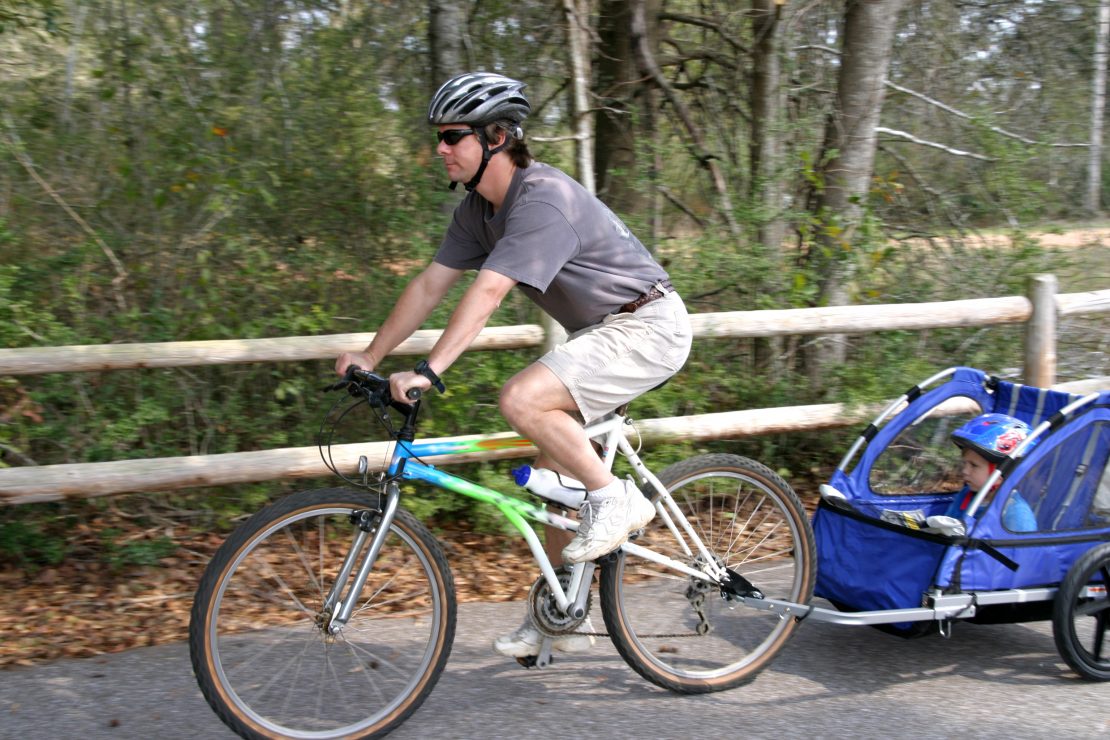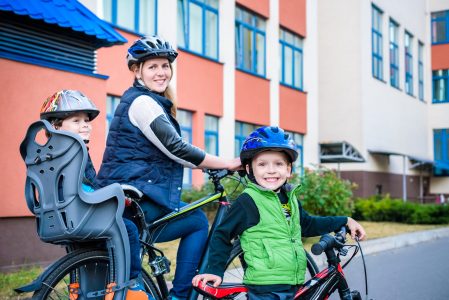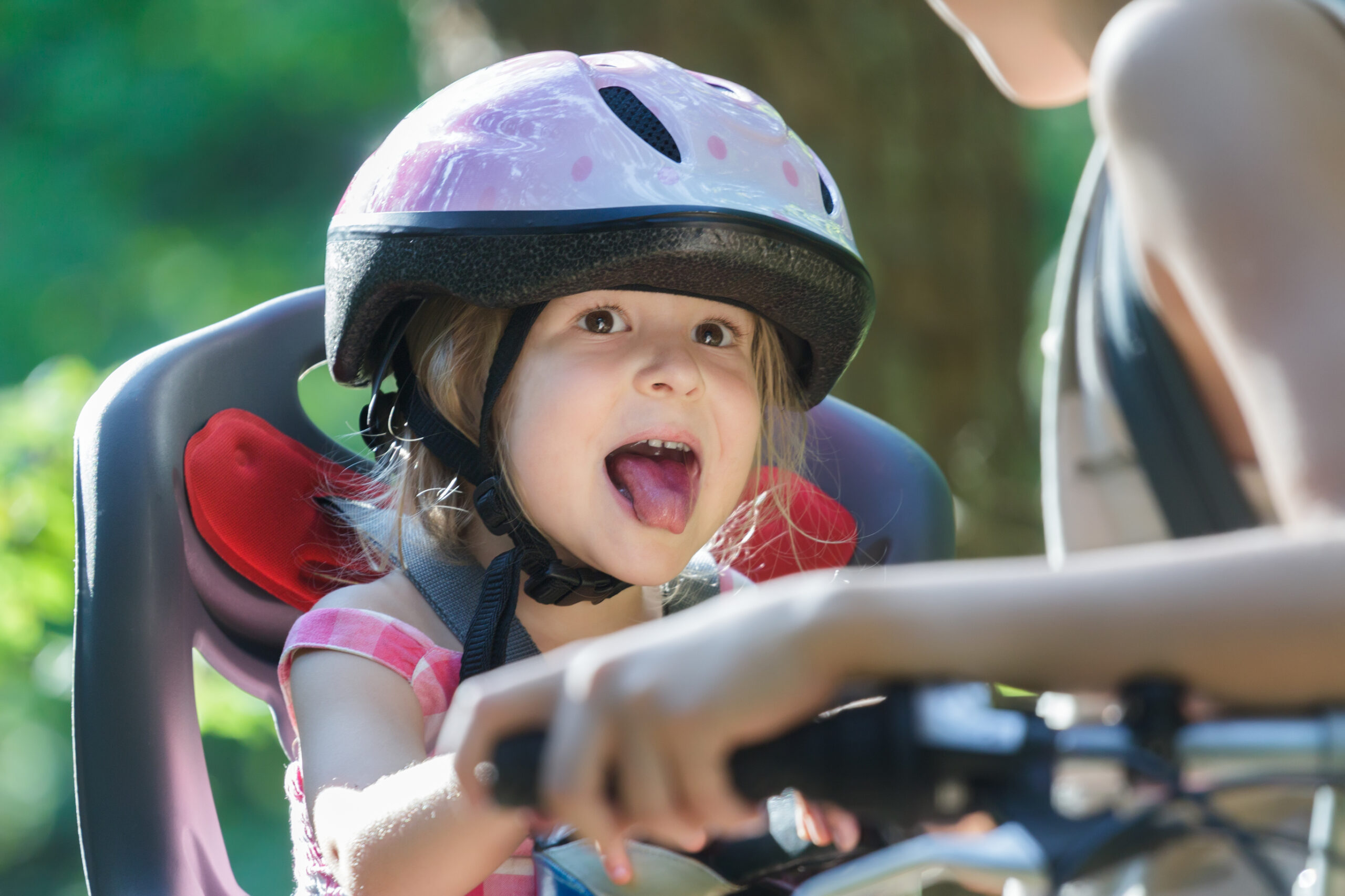Cycling with your child is a great way to get around and is fun for the whole family. Bike carriers and trailers help parents cycle safely with their child.
A bike carrier is a special seat that mounts on the frame of your bike.
A bike trailer is pulled behind your bike.
If you are trying to decide between a bike carrier and a bike trailer, here are some things to consider:
- A bike trailer is safer than a bike carrier because it won’t tip over if the bike falls.
- Bike carriers are less expensive than bike trailers and require less storage space.
- A child in a carrier can fall if the bicycle tips over, if the seat becomes detached or if the child is not properly fastened in the seat. A child falling from an adult bike would fall about one metre (three feet), which could result in serious injuries.
- You need to be a strong and confident cyclist to use a bike carrier.
Did you know?
Bike trailers are recommended for children between one to six years of age. While they tend to cost more than bike carriers, many models can also be used as strollers and some can carry two children.
Bike Trailers

What to look for in a bike trailer:
- Rollover type hitch so the trailer won’t tip if the bike tips
- Adaptable for children of different sizes
- Roll bars so that sides won’t collapse if the trailer tips
- Enough headroom to accommodate a helmet
- Five-point harness
- Sunshade and mesh screen front flap for protection from the sun, bugs, pebbles and debris
- Bright reflective material
- A flag for extra visibility
Safety Tips
- Follow the manufacturer’s age recommendations and instructions
- You and your child should wear a certified bike helmet that fits properly and is fastened correctly.
- Learn to be a confident cyclist. Take a bike safety course and get plenty of practice.
- Practice towing the bike trailer before taking your child out for a ride.
- Drive on bike paths and low traffic areas.
- Make wide turns to accommodate the trailer.
- Mount a bright orange flag on back of the trailer so motorists will see that you are towing a trailer.
- Use the harness or safety strap to fasten your child into the trailer.
- Use the cover or screen to protect your child from road dirt and debris.
- Don’t let the child eat in the trailer while you are cycling. This is so your child doesn’t choke.
Buying a second-hand bike trailer can make it more affordable.
- Bring your bike with you to make sure the trailer can be safely attached to your bike. The shape of your bike frame and disc brakes may get in the way.
- Look for wear and tear. The straps and fabric should be free of rips and tears.
- Make sure nothing is missing; trailers should include a cover or screen. A flag and reflectors improve your visibility.
Bike Carriers (Bicycle seats)

What to look for in a bike carrier:
- Foot wells or spoke guards to protect feet and ankles from the spokes
- Safety belt or harness
- Reflectors
- One that mounts behind the bike seat
- Front-mounted bike seats are available; however, they can limit your vision, your ability to steer and lean forward. Strong cyclists may be more comfortable with this style of carrier.
Did you know?
Not every bike is compatible with a child bike seat. Check the instructions and ensure that any seat you use is installed correctly and does not wiggle or move on the bike.
Safety Tips:
- The American Academy of Pediatrics recommends that a child be at least one year of age before riding in a bike carrier.
- Follow the bike carrier manufacturer’s age recommendations and instructions.
- Parent and child should always wear a properly fitted and fastened certified bike helmet.
- Learn to be a confident cyclist. Take a bike safety course and get plenty of practice.
- Never leave your child unattended in bike carrier.
- Child should wear close fitting clothing and not have blankets, drawstrings or toys that could get caught in the spokes or gears.
- Drive on smooth bike paths and low traffic streets.
Reference
Baby on Board: Keeping Safe on a Bike– American Academy of Pediatrics


